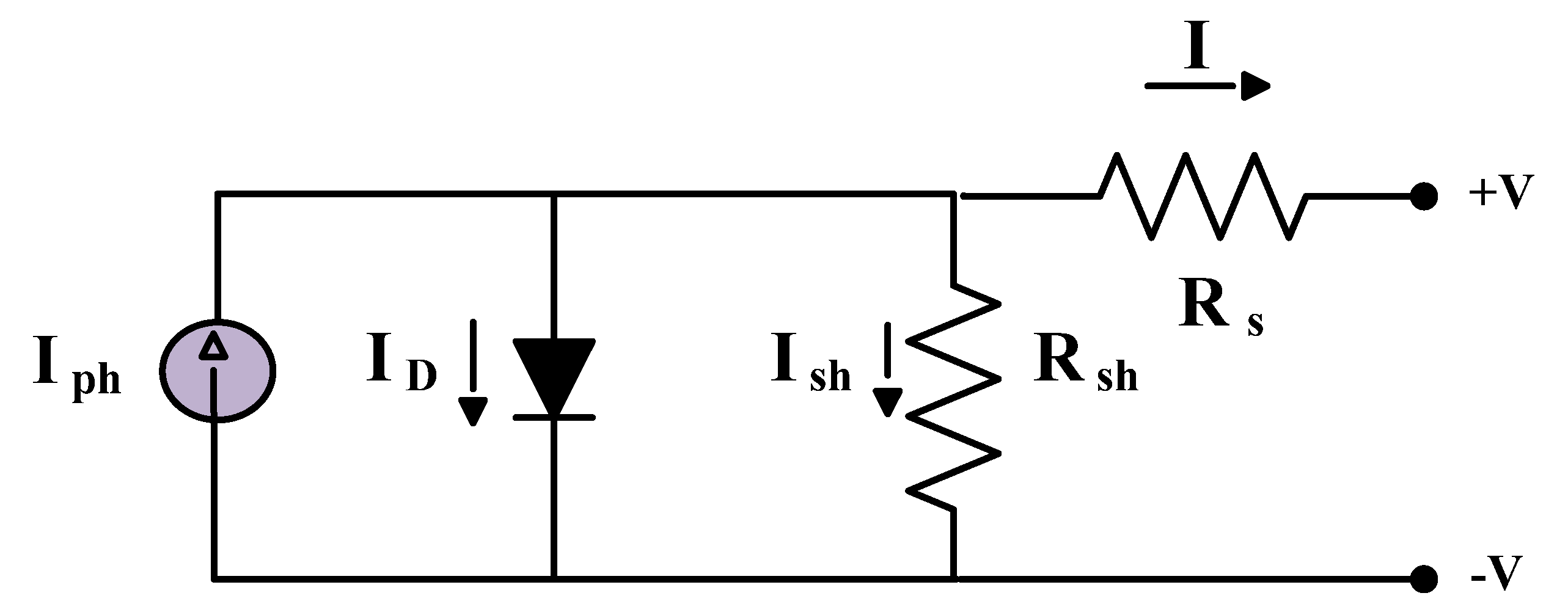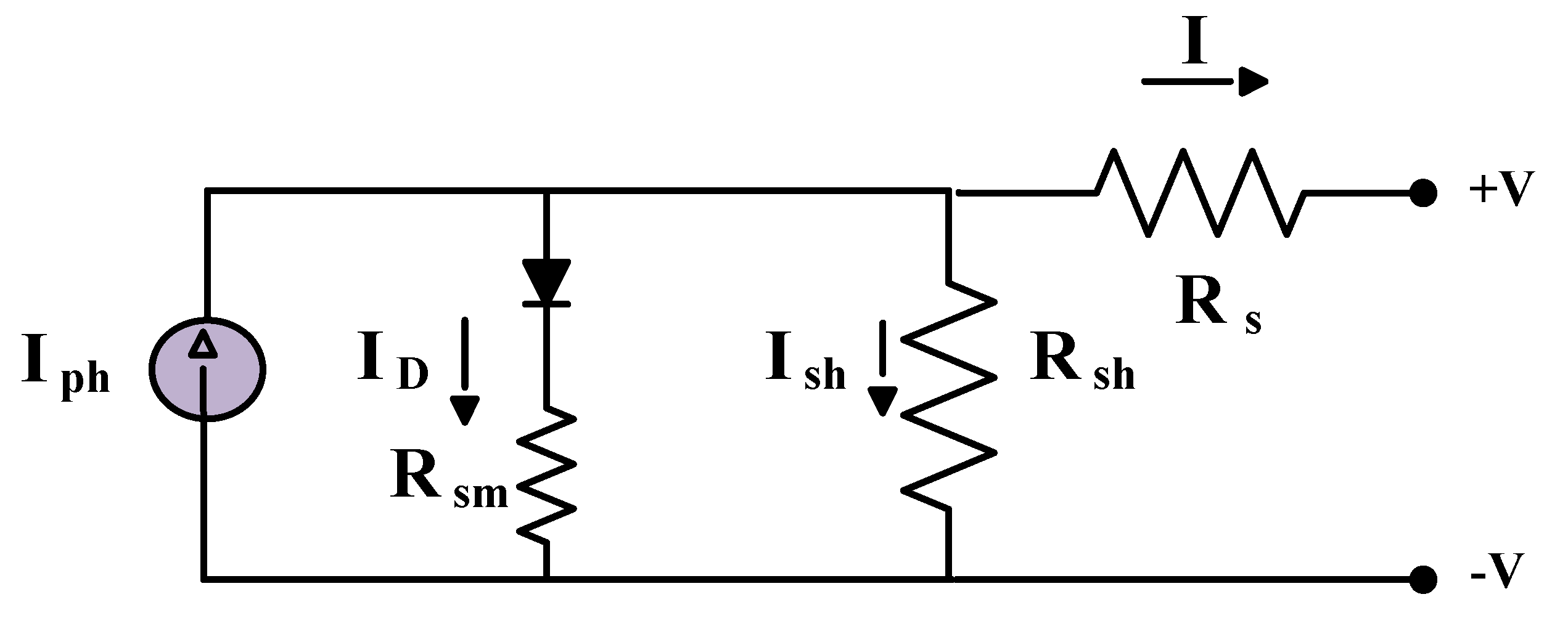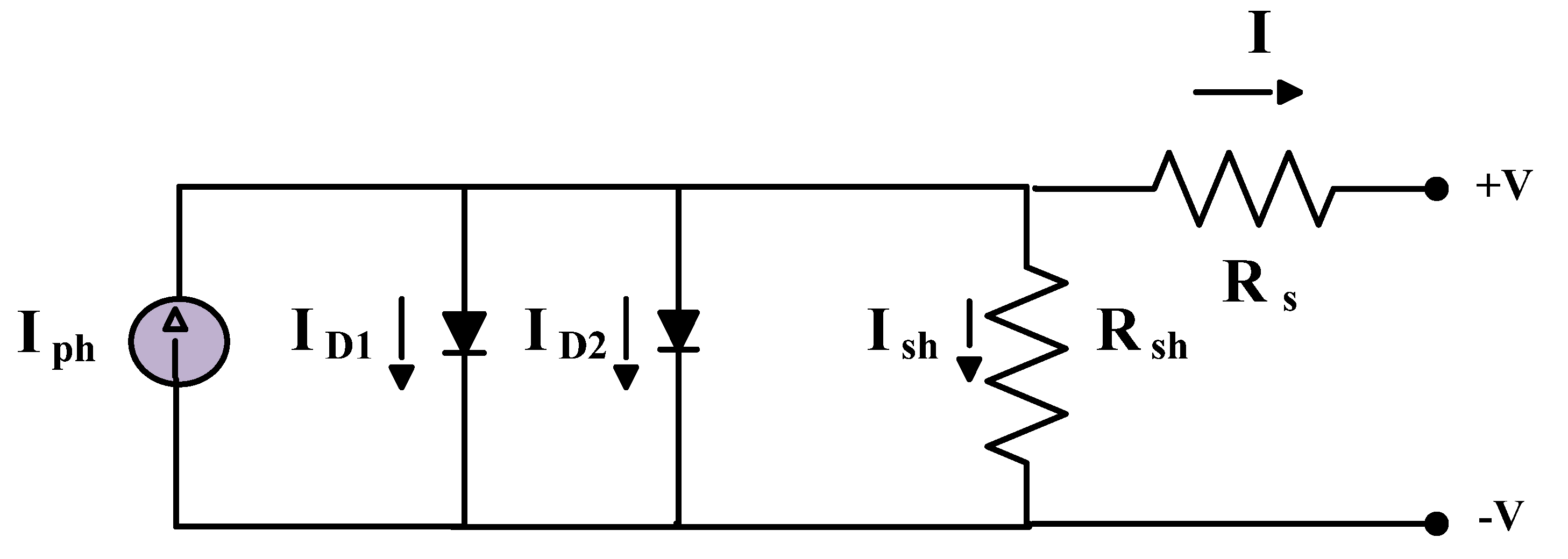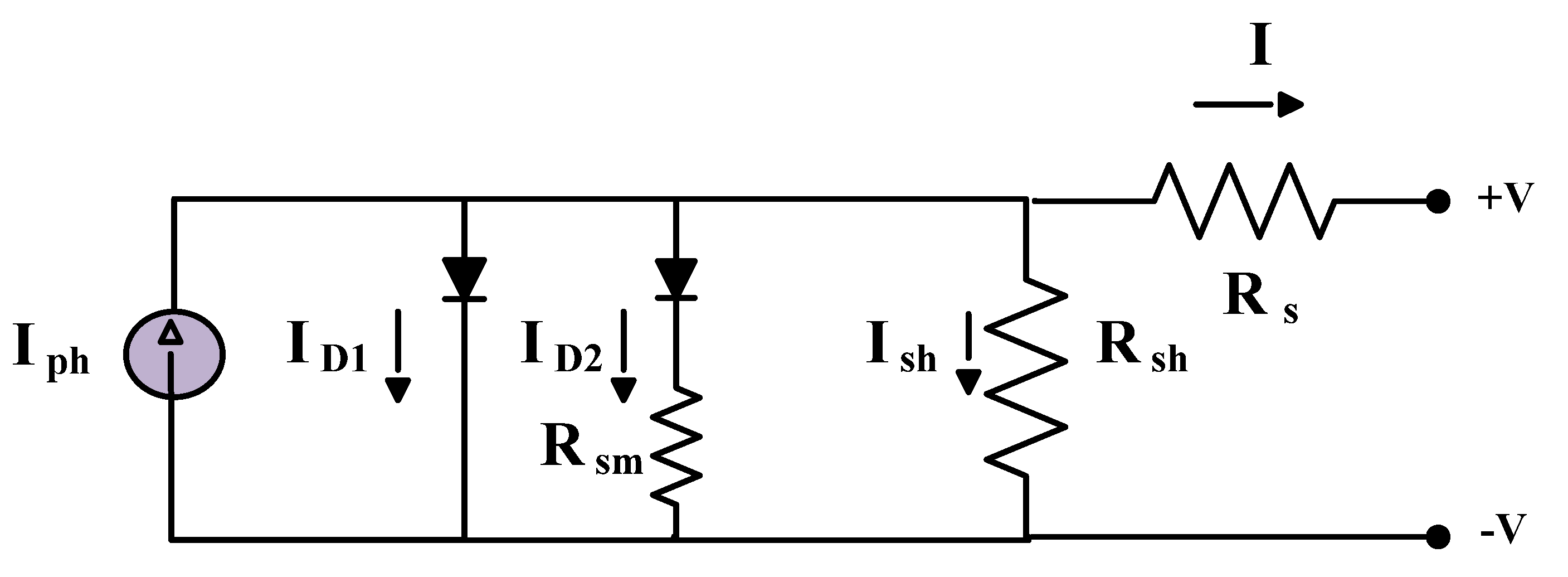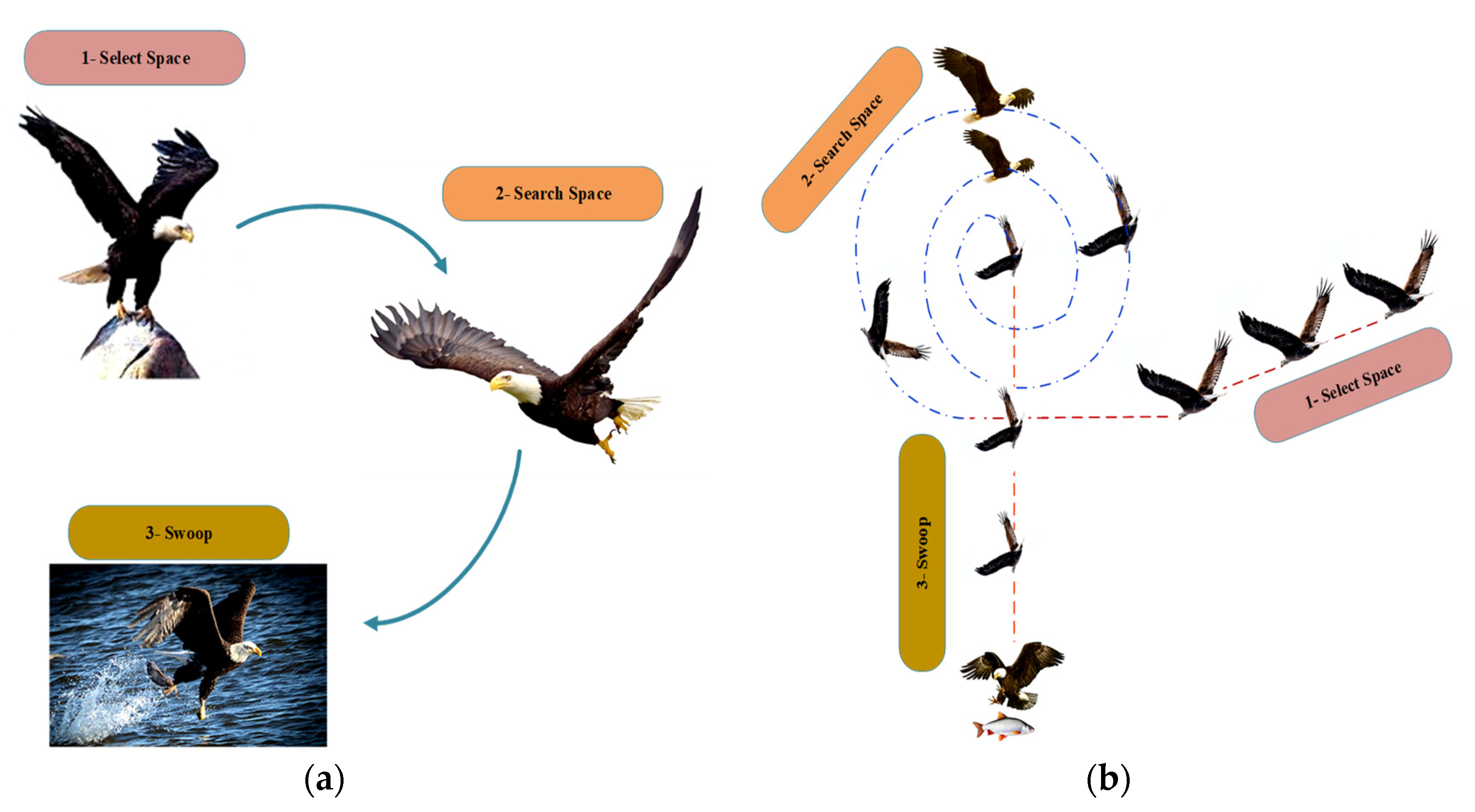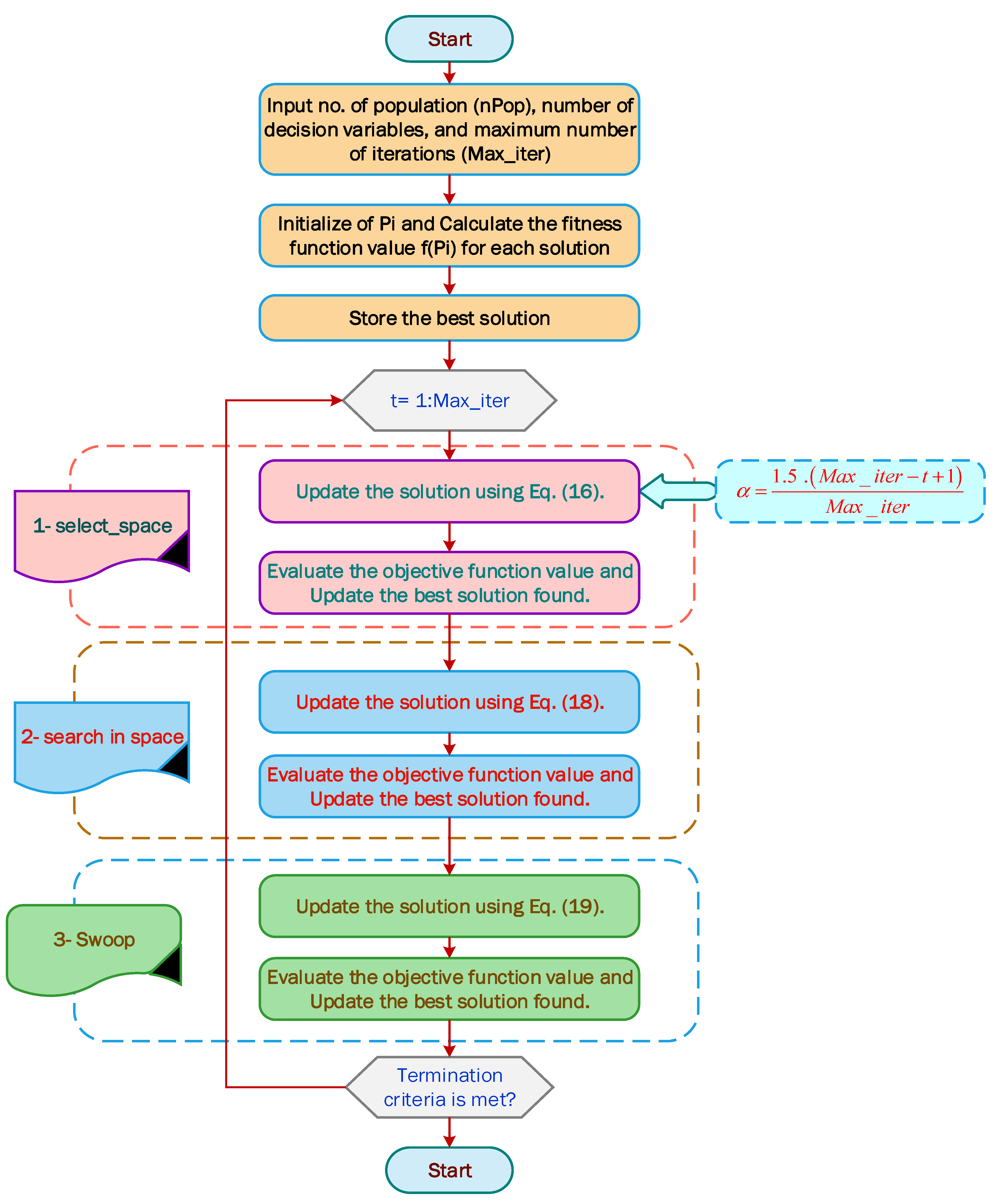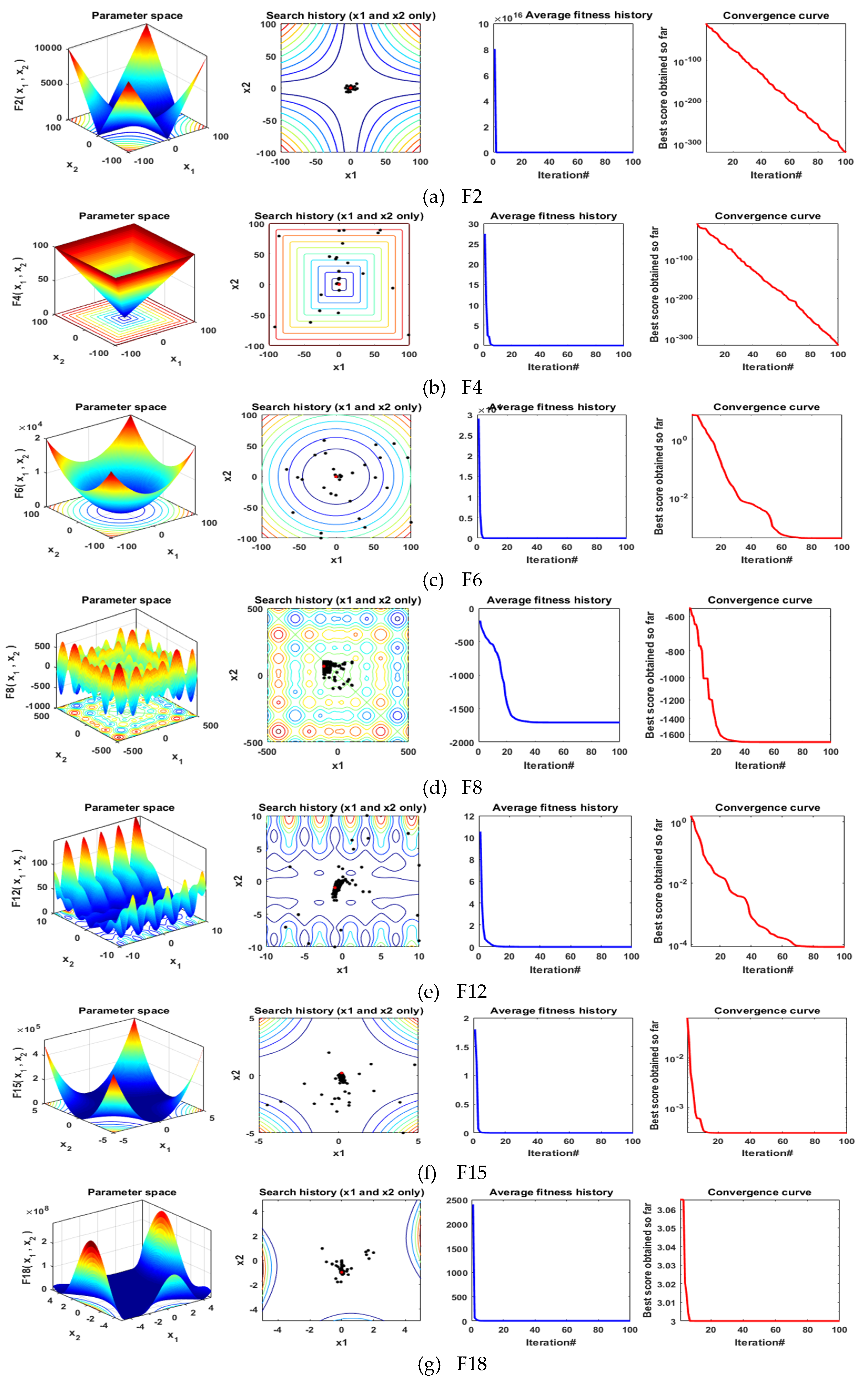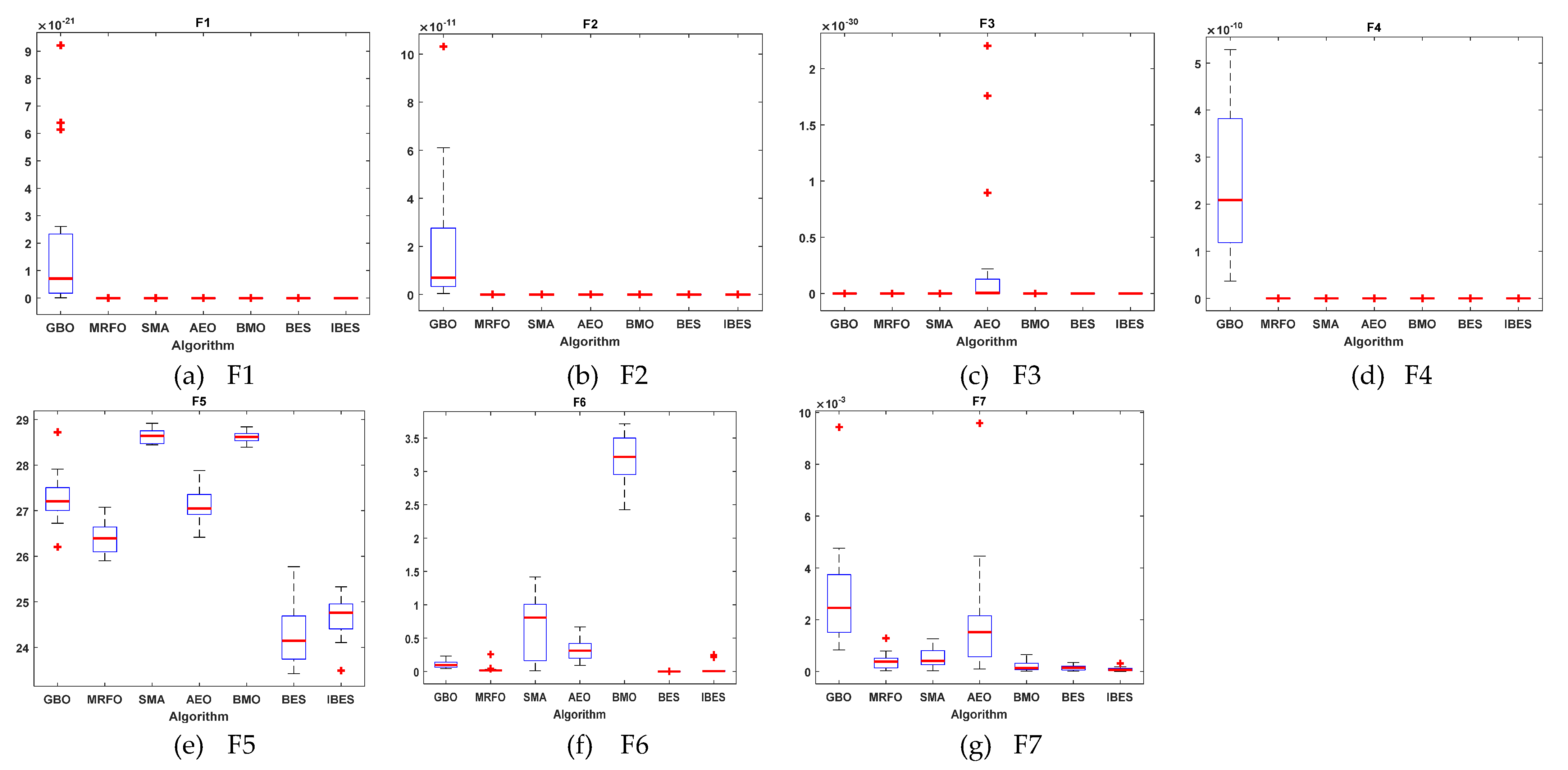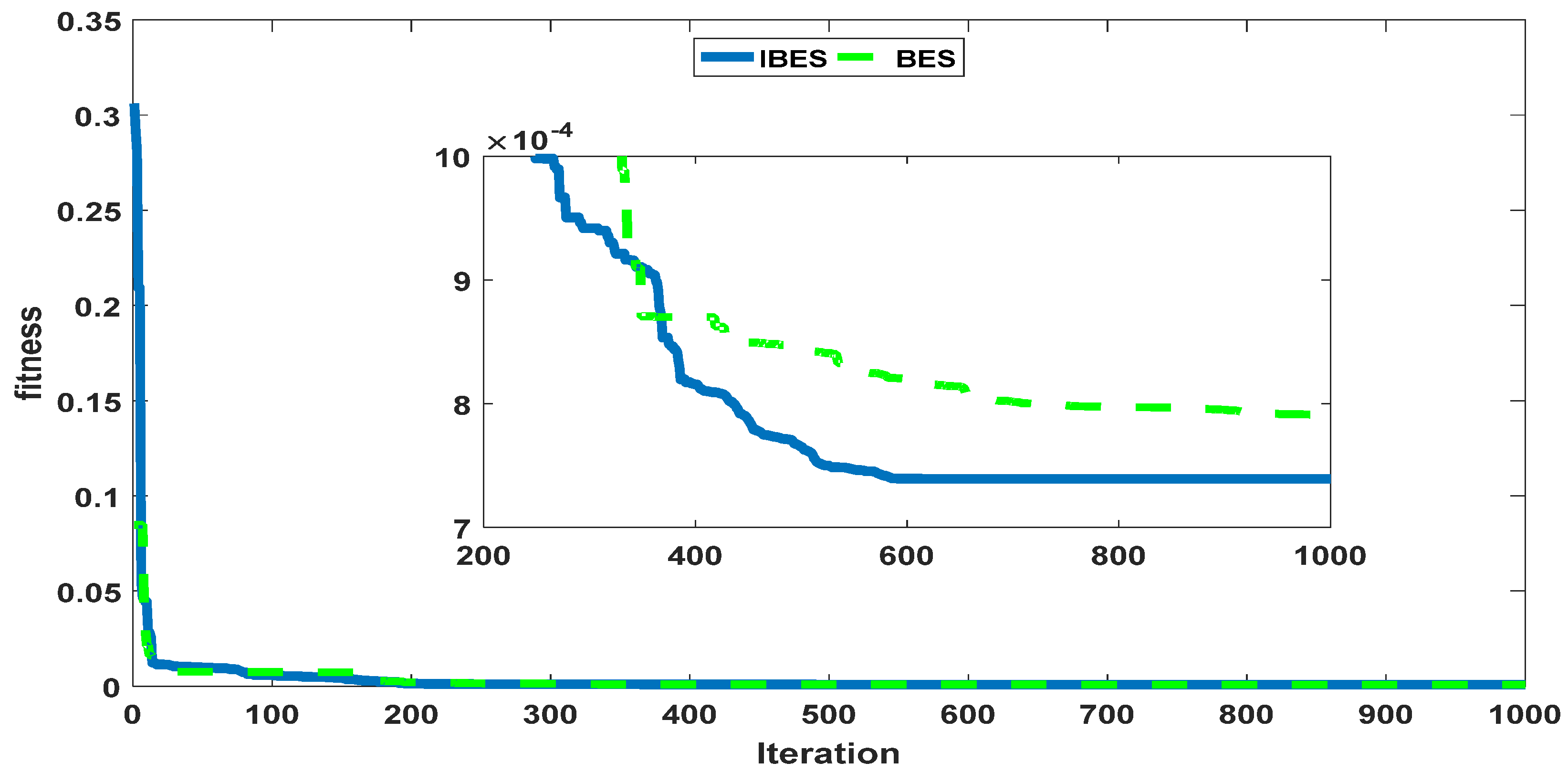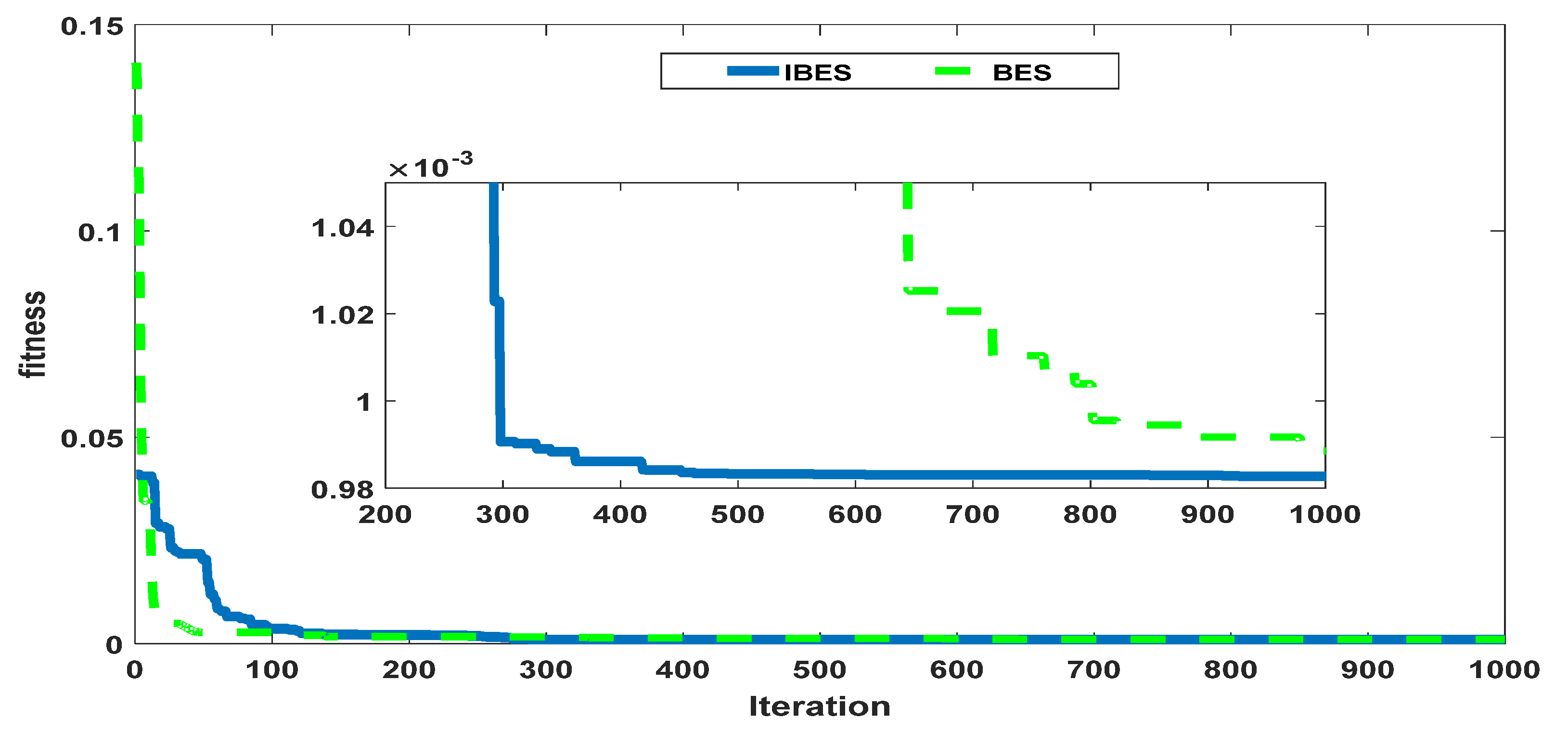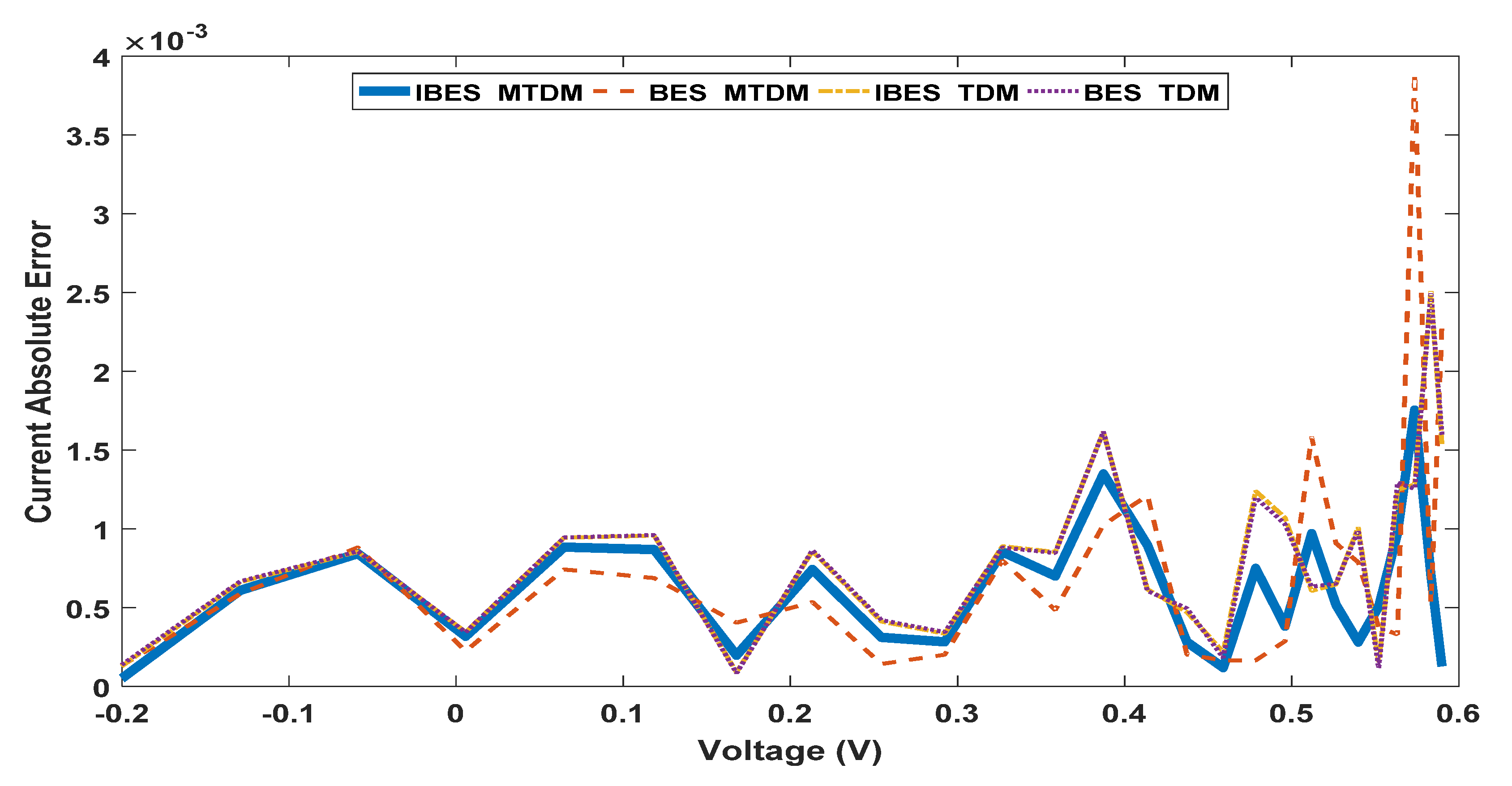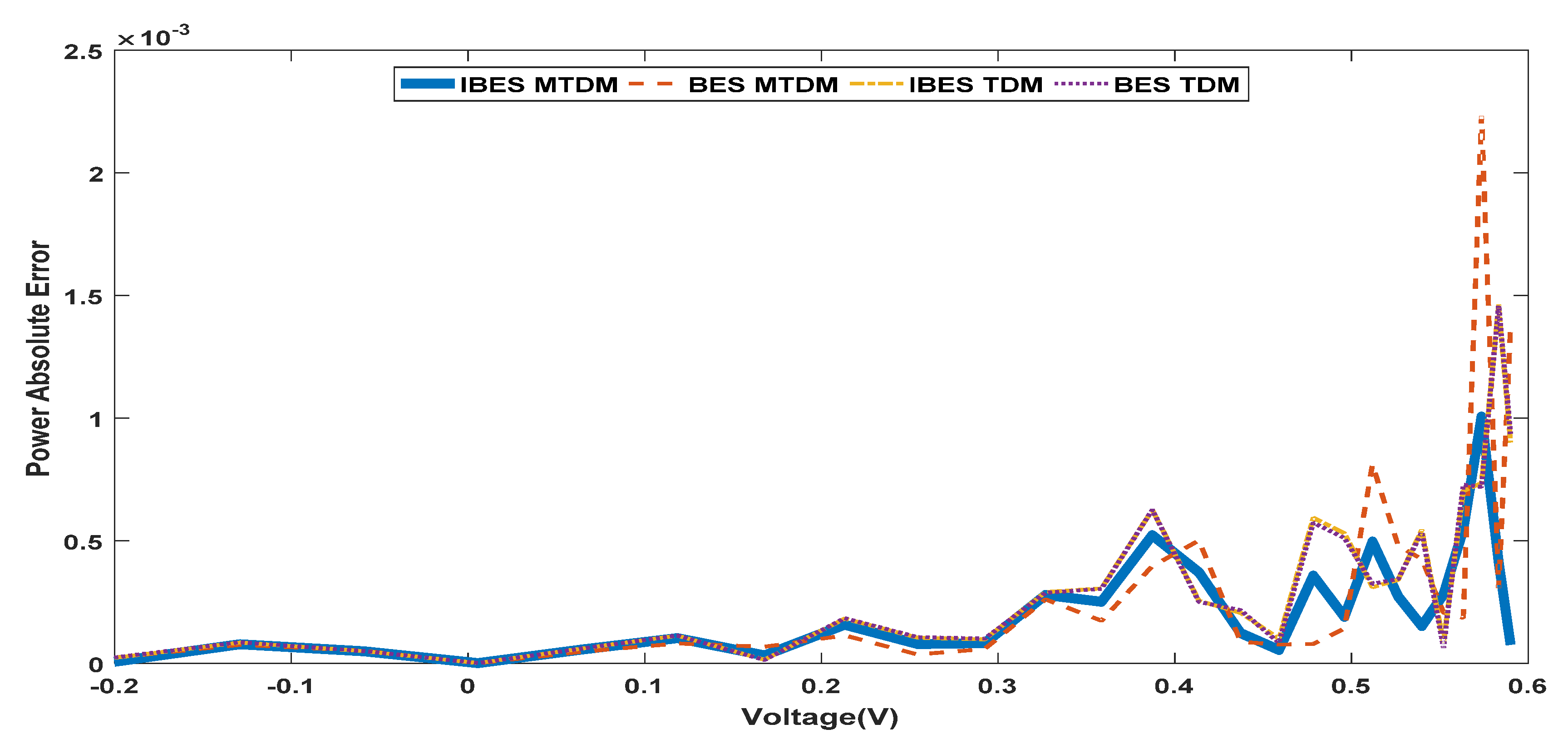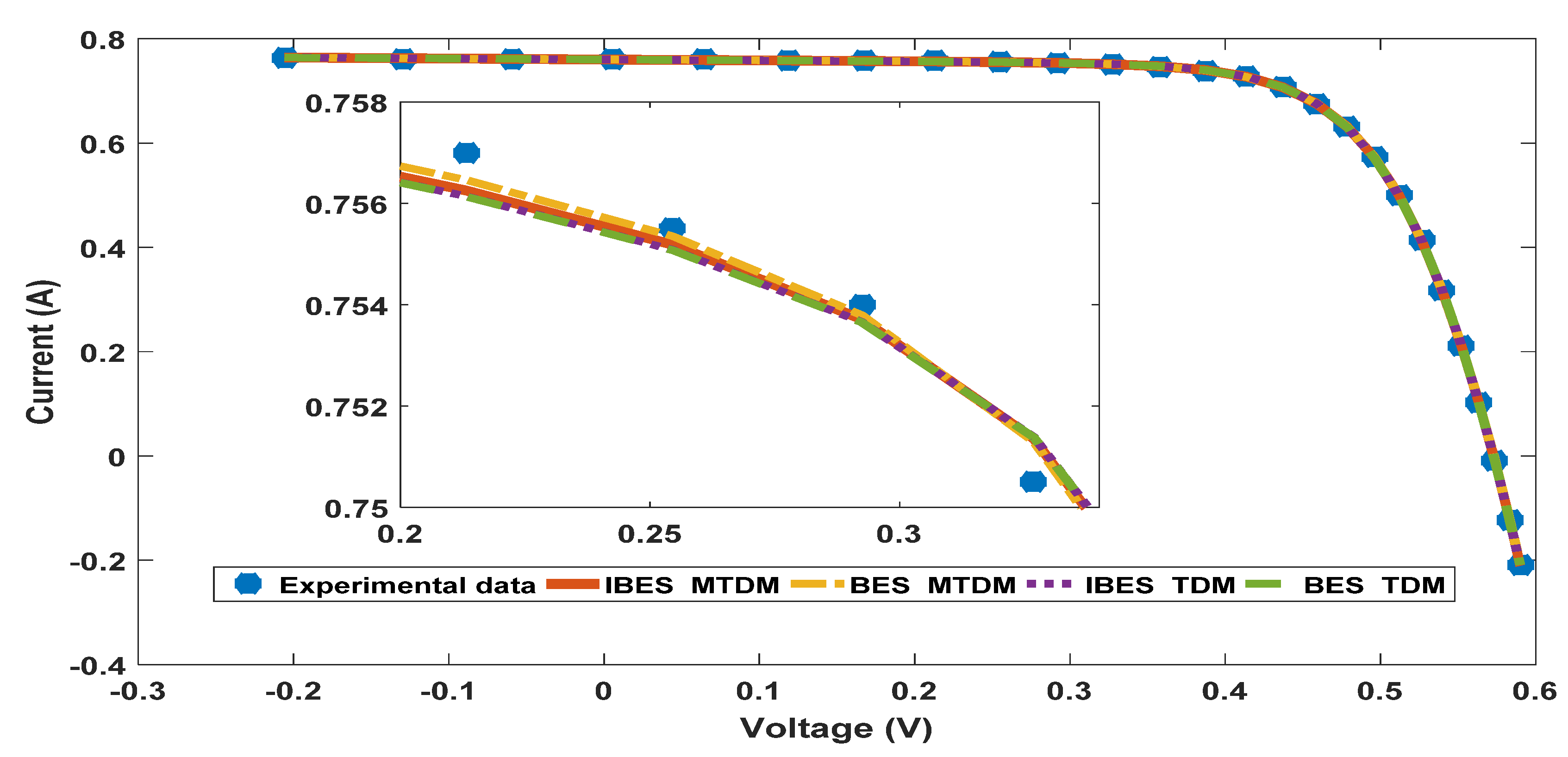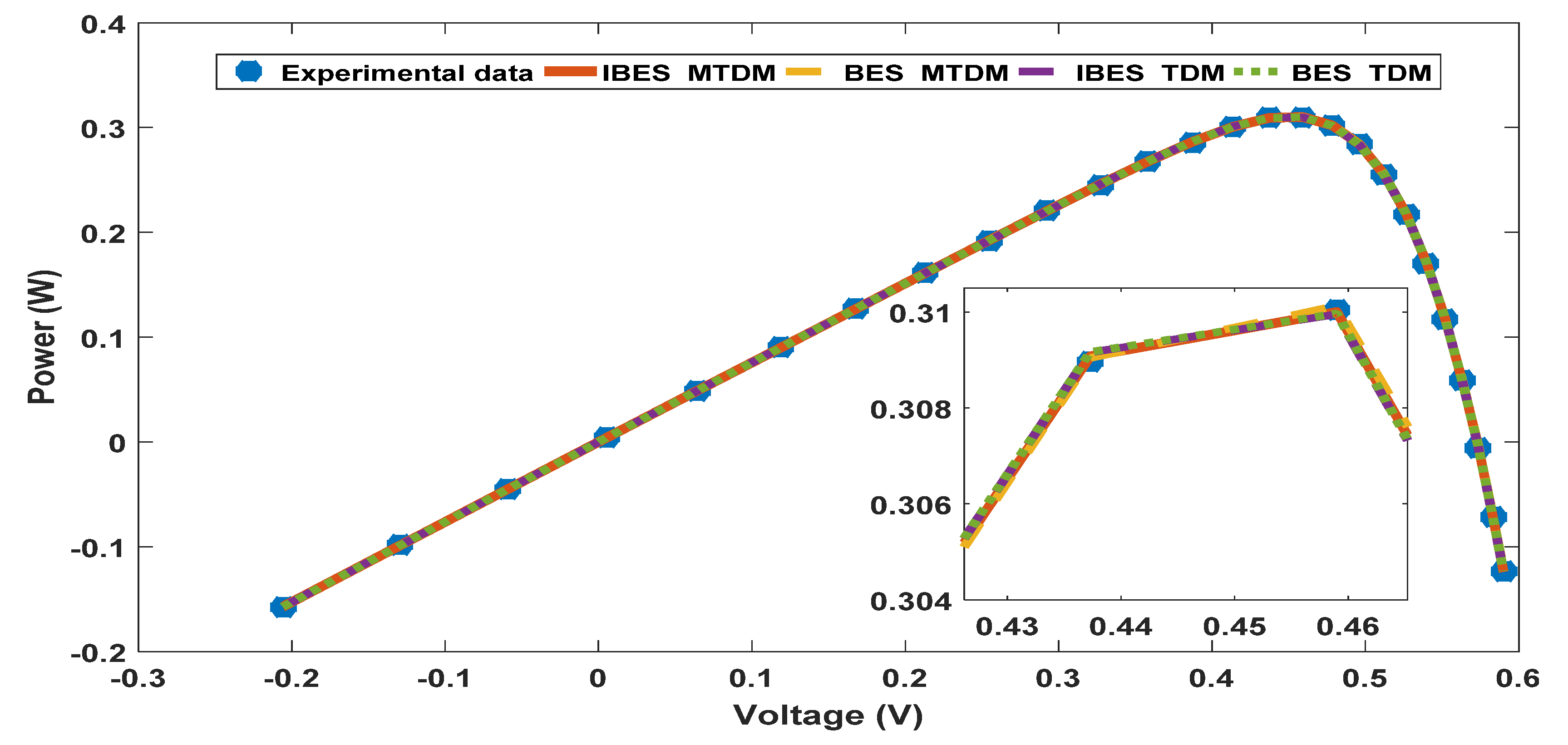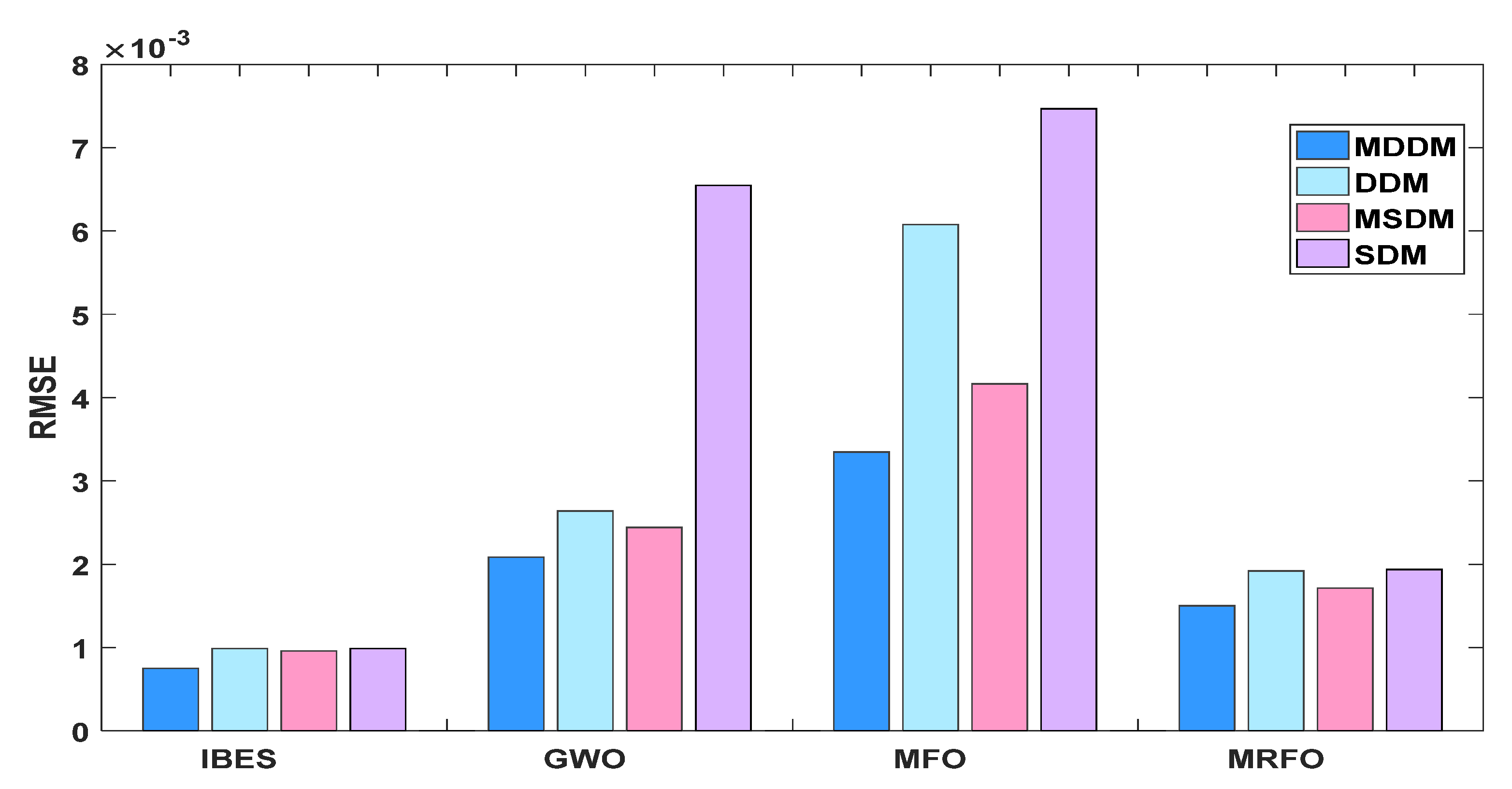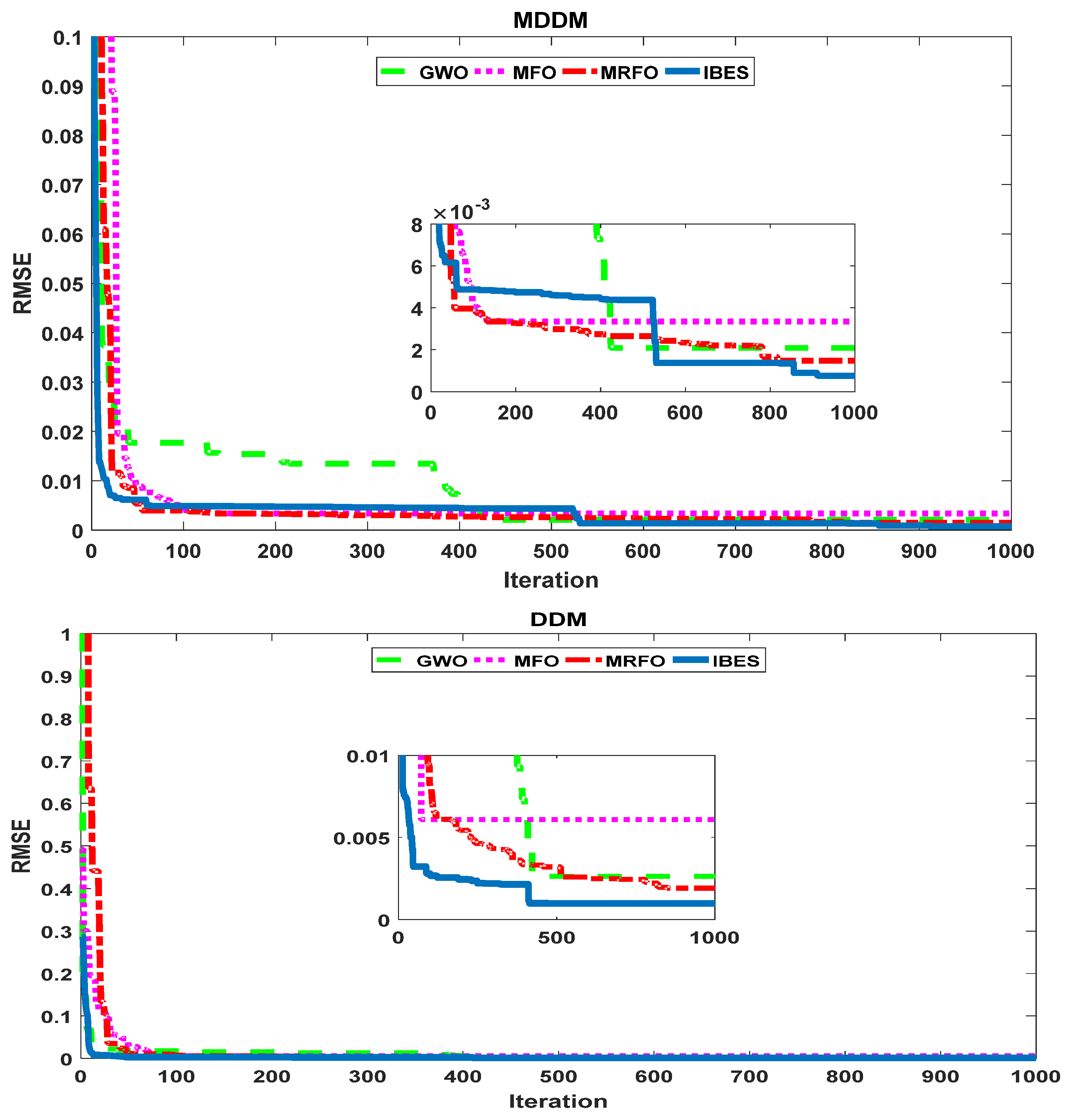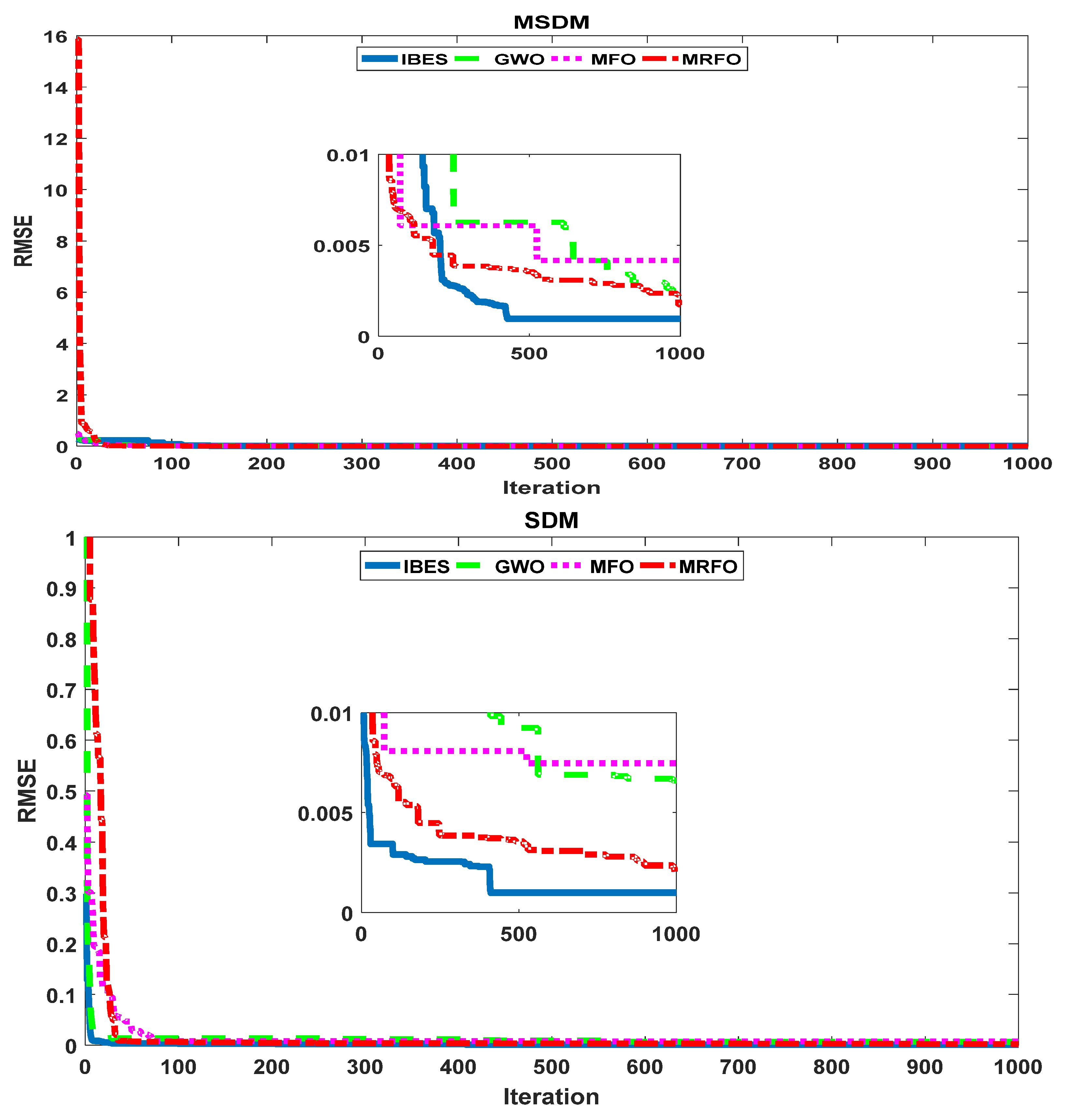Author Contributions
Conceptualization, A.R. and S.K.; methodology, T.K., M.H.H. and C.R.; software, A.R. S.K. and M.H.H.; validation, T.K. and C.R.; formal analysis, A.R., S.K and M.H.H.; investigation, T.K. and C.R.; resources, A.R., S.K. and M.H.H.; data curation, T.K. and C.R.; writing—original draft preparation, A.R., S.K. and M.H.H.; writing—review and editing, T.K. and C.R.; visualization, T.K. and C.R.; supervision, S.K.; project administration, A.R. and A.R. All authors have read and agreed to the published version of the manuscript.
Figure 7.
(a) Behavior of bald eagle during hunting; (b) sequential stages of bald eagle hunting.
Figure 7.
(a) Behavior of bald eagle during hunting; (b) sequential stages of bald eagle hunting.
Figure 8.
Flowchart for the IBES algorithm.
Figure 8.
Flowchart for the IBES algorithm.
Figure 9.
Qualitative metrics for the (a) F2, (b) F4, (c) F6, (d) F8, (e) F12, (f) F15, and (g) F18 functions: 2D views of the functions, search histories, average fitness histories, and convergence curves.
Figure 9.
Qualitative metrics for the (a) F2, (b) F4, (c) F6, (d) F8, (e) F12, (f) F15, and (g) F18 functions: 2D views of the functions, search histories, average fitness histories, and convergence curves.
Figure 10.
Boxplots for all algorithms for unimodal benchmark functions (a) F1, (b) F2, (c) F3, (d) F4, (e) F5, (f) F6, and (g) F7.
Figure 10.
Boxplots for all algorithms for unimodal benchmark functions (a) F1, (b) F2, (c) F3, (d) F4, (e) F5, (f) F6, and (g) F7.
Figure 11.
Boxplots for all algorithms for multimodal benchmark functions (a) F8, (b) F10, (c) F12, and (d) F13.
Figure 11.
Boxplots for all algorithms for multimodal benchmark functions (a) F8, (b) F10, (c) F12, and (d) F13.
Figure 12.
Boxplots for all algorithms for composite benchmark functions (a) F14, (b) F15, (c) F16, (d) F17, (e) F18, (f) F19, (g) F20, (h) F21, (i) F22, and (j) F23.
Figure 12.
Boxplots for all algorithms for composite benchmark functions (a) F14, (b) F15, (c) F16, (d) F17, (e) F18, (f) F19, (g) F20, (h) F21, (i) F22, and (j) F23.
Figure 13.
The convergence curves for the IBES and BES for the MTDM.
Figure 13.
The convergence curves for the IBES and BES for the MTDM.
Figure 14.
The convergence curves of the IBES and BES for the TDM.
Figure 14.
The convergence curves of the IBES and BES for the TDM.
Figure 15.
Boxplot for the IBES applied to the MTDM and TDM and the BES applied to the MTDM and TDM for 30 independent runs.
Figure 15.
Boxplot for the IBES applied to the MTDM and TDM and the BES applied to the MTDM and TDM for 30 independent runs.
Figure 16.
IAE for the IBES and BES for all cases.
Figure 16.
IAE for the IBES and BES for all cases.
Figure 17.
PAE for the IBES and BES for all cases.
Figure 17.
PAE for the IBES and BES for all cases.
Figure 18.
Current–voltage curve for the experimental data and for the MTDM, and TDM currents estimated by the IBES and BES.
Figure 18.
Current–voltage curve for the experimental data and for the MTDM, and TDM currents estimated by the IBES and BES.
Figure 19.
Power–voltage curve for the experimental data and for the MTDM and TDM currents estimated by the IBES and BES.
Figure 19.
Power–voltage curve for the experimental data and for the MTDM and TDM currents estimated by the IBES and BES.
Figure 20.
Comparison between the RMSE values of the IBES, GWO, MFO, and MRFO applied to the MDDM, DDM, MSDM, and SDM.
Figure 20.
Comparison between the RMSE values of the IBES, GWO, MFO, and MRFO applied to the MDDM, DDM, MSDM, and SDM.
Figure 21.
The convergence curves of the IBES, GWO, MFO, and MRFO applied to the MDDM, DDM, MSDM, and SDM.
Figure 21.
The convergence curves of the IBES, GWO, MFO, and MRFO applied to the MDDM, DDM, MSDM, and SDM.
Figure 22.
Boxplots of the IBES, GWO, MFO, and MRFO applied to the MDDM, DDM, MSDM and SDM.
Figure 22.
Boxplots of the IBES, GWO, MFO, and MRFO applied to the MDDM, DDM, MSDM and SDM.
Table 1.
Parameter settings of the selected techniques.
Table 1.
Parameter settings of the selected techniques.
| Algorithms | Parameters Setting |
|---|
| Common settings | Population size: nPop = 50 |
| Maximum iterations: Max_iter = 100 |
| Number of independent runs = 30 |
| GBO | Probability Parameter: Pr = 0.5 |
| MRFO | S = 2 |
| SMA | Z = 0.03 |
| BMO | Pl = 7 |
| BES | C1, C2, α = 2, a = 10, R = 1.5 |
| IBES | C1, C2 =2, a = 10, R = 1.5 |
Table 2.
Results for unimodal benchmark functions.
Table 2.
Results for unimodal benchmark functions.
| Function | GBO | MRFO | SMA | AEO | BMO | BES | IBES |
|---|
| F1 | Best | 1.00 × 10−23 | 1.23 × 10−90 | 6.92 × 10−156 | 7.97 × 10−42 | 2.11 × 10−141 | 0 | 0 |
| Worst | 9.21 × 10−21 | 1.64 × 10−80 | 8.85 × 10−85 | 2.26 × 10−33 | 6.12 × 10−123 | 0 | 0 |
| Mean | 1.92 × 10−21 | 9.98 × 10−82 | 4.59 × 10−86 | 2.50 × 10−34 | 3.10 × 10−124 | 0 | 0 |
| std | 2.79 × 10−21 | 3.68 × 10−81 | 1.98 × 10−85 | 5.82 × 10−34 | 1.37 × 10−123 | 0 | 0 |
| F2 | Best | 4.32 × 10−13 | 1.12 × 10−45 | 4.30 × 10−79 | 1.36 × 10−22 | 6.59 × 10−73 | 0 | 0 |
| Worst | 1.03 × 10−10 | 5.26 × 10−42 | 3.70 × 10−46 | 6.59 × 10−17 | 1.47 × 10−62 | 1.37 × 10−270 | 4.47 × 10−303 |
| Mean | 1.96 × 10−11 | 5.11 × 10−43 | 1.85 × 10−47 | 9.84 × 10−18 | 7.69 × 10−64 | 6.85 × 10−272 | 2.73 × 10−304 |
| std | 2.66 × 10−11 | 1.20 × 10−42 | 8.28 × 10−47 | 1.84 × 10−17 | 3.29 × 10−63 | 0 | 0 |
| F3 | Best | 5.08 × 10−50 | 2.87 × 10−127 | 3.06 × 10−134 | 3.44 × 10−38 | 3.84 × 10−148 | 0 | 0 |
| Worst | 7.79 × 10−45 | 2.24 × 10−117 | 7.31 × 10−63 | 2.20 × 10−30 | 1.60 × 10−123 | 0 | 0 |
| Mean | 4.20 × 10−46 | 1.54 × 10−118 | 6.45 × 10−64 | 2.84 × 10−31 | 9.27 × 10−125 | 0 | 0 |
| std | 1.74 × 10−45 | 5.05 × 10−118 | 2.00 × 10−63 | 6.19 × 10−31 | 3.55 × 10−124 | 0 | 0 |
| F4 | Best | 3.69 × 10−11 | 8.16 × 10−46 | 6.02 × 10−69 | 2.55 × 10−21 | 6.93 × 10−70 | 0 | 0 |
| Worst | 5.29 × 10−10 | 1.66 × 10−40 | 1.39 × 10−35 | 8.30 × 10−17 | 1.55 × 10−62 | 1.51 × 10−260 | 1.60 × 10−294 |
| Mean | 2.49 × 10−10 | 1.72 × 10−41 | 7.81 × 10−37 | 1.38 × 10−17 | 1.19 × 10−63 | 7.56 × 10−262 | 8.32 × 10−296 |
| std | 1.68 × 10−10 | 3.92 × 10−41 | 3.10 × 10−36 | 2.44 × 10−17 | 3.63 × 10−63 | 0 | 0 |
| F5 | Best | 26.20355 | 25.89819 | 28.4411 | 26.41348 | 28.39232 | 23.42343 | 23.49114 |
| Worst | 28.72399 | 27.07267 | 28.91551 | 27.87792 | 28.83662 | 25.76698 | 25.32653 |
| Mean | 27.28987 | 26.39814 | 28.61466 | 27.1144 | 28.61644 | 24.26849 | 24.66361 |
| std | 0.554629 | 0.344638 | 0.162272 | 0.409592 | 0.125605 | 0.6296 | 0.461041 |
| F6 | Best | 0.03963 | 0.001831 | 0.008039 | 0.090625 | 2.424723 | 6.7 × 10−7 | 1.43 × 10−5 |
| Worst | 0.228144 | 0.255766 | 1.4177 | 0.66915 | 3.710475 | 7.96 × 10−5 | 0.249381 |
| Mean | 0.102408 | 0.02639 | 0.679072 | 0.333799 | 3.174803 | 1.79 × 10−5 | 0.03938 |
| std | 0.049555 | 0.055015 | 0.458967 | 0.173604 | 0.395355 | 2.61 × 10−5 | 0.084456 |
| F7 | Best | 0.000839 | 2.28 × 10−5 | 2.68 × 10−5 | 9.34 × 10−5 | 8.21 × 10−6 | 1.58 × 10−5 | 2.25 × 10−6 |
| Worst | 0.009435 | 0.00129 | 0.001258 | 0.009584 | 0.00065 | 0.000348 | 0.00031 |
| Mean | 0.002914 | 0.000388 | 0.000551 | 0.001969 | 0.000201 | 0.000142 | 8.49 × 10−5 |
| std | 0.001943 | 0.0003 | 0.000371 | 0.002193 | 0.000168 | 9.99 × 10−5 | 7.8 × 10−5 |
Table 3.
Results for multimodal benchmark functions.
Table 3.
Results for multimodal benchmark functions.
| Function | GBO | MRFO | SMA | AEO | BMO | BES | IBES |
|---|
| F8 | Best | −1830.71 | −1608.25 | −1909.05 | −1759.19 | −1454.34 | −1777.18 | −1731.16 |
| Worst | −1642.02 | −1250.53 | −1905.97 | −1400.39 | −800.961 | −1043.35 | −1354.55 |
| Mean | −1720.61 | −1460.49 | −1908.16 | −1608.48 | −1161.96 | −1503.62 | −1543.11 |
| std | 43.85651 | 95.02298 | 0.79786 | 93.70687 | 155.4007 | 256.3825 | 100.2304 |
| F9 | Best | 0 | 0 | 0 | 0 | 0 | 0 | 0 |
| Worst | 0 | 0 | 0 | 0 | 0 | 0 | 0 |
| Mean | 0 | 0 | 0 | 0 | 0 | 0 | 0 |
| std | 0 | 0 | 0 | 0 | 0 | 0 | 0 |
| F10 | Best | 8.88 × 10−16 | 8.88 × 10−16 | 8.88 × 10−16 | 8.88 × 10−16 | 8.88 × 10−16 | 8.88 × 10−16 | 8.88 × 10−16 |
| Worst | 3.7 × 10−8 | 8.88 × 10−16 | 8.88 × 10−16 | 4.44 × 10−15 | 8.88 × 10−16 | 20 | 20 |
| Mean | 4.09 × 10−9 | 8.88 × 10−16 | 8.88 × 10−16 | 1.24 × 10−15 | 8.88 × 10−16 | 18 | 11 |
| std | 8.72 × 10−9 | 0 | 0 | 1.09 × 10−15 | 0 | 6.15587 | 10.20836 |
| F11 | Best | 0 | 0 | 0 | 0 | 0 | 0 | 0 |
| Worst | 2.04 × 10−9 | 0 | 0 | 0 | 0 | 0 | 0 |
| Mean | 1.02 × 10−10 | 0 | 0 | 0 | 0 | 0 | 0 |
| std | 4.56 × 10−10 | 0 | 0 | 0 | 0 | 0 | 0 |
| F12 | Best | 0.000366 | 6.18 × 10−5 | 1.52 × 10−5 | 0.001042 | 0.141918 | 2.91 × 10−9 | 6.53 × 10−6 |
| Worst | 0.00209 | 0.000955 | 0.018428 | 0.004707 | 0.430386 | 3.41 × 10−7 | 9.95 × 10−5 |
| Mean | 0.001236 | 0.000306 | 0.003839 | 0.00285 | 0.233487 | 1.04 × 10−7 | 4.13 × 10−5 |
| std | 0.000492 | 0.000203 | 0.00548 | 0.001198 | 0.072019 | 1.21 × 10−7 | 2.55 × 10−5 |
| F13 | Best | 0.104263 | 0.106128 | 0.001662 | 0.530081 | 2.975561 | 2.24745 | 1.95995 |
| Worst | 0.475712 | 2.967327 | 2.530503 | 2.970408 | 2.984392 | 2.966102 | 2.968414 |
| Mean | 0.2188 | 2.328378 | 0.789293 | 1.665532 | 2.980695 | 2.904654 | 2.916155 |
| std | 0.089562 | 1.053699 | 0.891767 | 0.894496 | 0.002041 | 0.192063 | 0.225068 |
Table 4.
Results for composite benchmark functions.
Table 4.
Results for composite benchmark functions.
| Function | GBO | MRFO | SMA | AEO | BMO | BES | IBES |
|---|
| F14 | Best | 0.998004 | 0.998004 | 0.998004 | 0.998004 | 0.998004 | 0.998004 | 0.998004 |
| Worst | 3.96825 | 0.998004 | 1.992031 | 0.998004 | 12.67051 | 12.67051 | 0.998004 |
| Mean | 1.196218 | 0.998004 | 1.047705 | 0.998004 | 9.589146 | 1.978449 | 0.998004 |
| std | 0.68919 | 4.62 × 10−11 | 0.222271 | 1.53 × 10−16 | 4.153516 | 2.643447 | 1.91 × 10−16 |
| F15 | Best | 0.000307 | 0.000308 | 0.000309 | 0.000307 | 0.000308 | 0.000307 | 0.000307 |
| Worst | 0.020363 | 0.020364 | 0.001579 | 0.001223 | 0.00073 | 0.020363 | 0.001223 |
| Mean | 0.001647 | 0.001347 | 0.00081 | 0.000359 | 0.000406 | 0.001356 | 0.000358 |
| std | 0.004469 | 0.004476 | 0.000409 | 0.000204 | 0.000123 | 0.004479 | 0.000204 |
| F16 | Best | −1.03163 | −1.03163 | −1.03163 | −1.03163 | −1.03163 | −1.03163 | −1.03163 |
| Worst | −1.03163 | −1.03163 | −1.03163 | −1.03163 | −1.03163 | −1.03163 | −1.03163 |
| Mean | −1.03163 | −1.03163 | −1.03163 | −1.03163 | −1.03163 | −1.03163 | −1.03163 |
| std | 8.82 × 10−17 | 1.69 × 10−16 | 3.00 × 10−8 | 1.14 × 10−16 | 2.31 × 10−9 | 2.16 × 10−16 | 2.10 × 10−16 |
| F17 | Best | 0.397887 | 0.397887 | 0.397887 | 0.397887 | 0.397887 | 0.397887 | 0.397887 |
| Worst | 0.397887 | 0.397887 | 0.39789 | 0.397887 | 0.397888 | 0.397887 | 0.397887 |
| Mean | 0.397887 | 0.397887 | 0.397888 | 0.397887 | 0.397887 | 0.397887 | 0.397887 |
| std | 0 | 0 | 8.28 × 10−7 | 0 | 4.58 × 10−8 | 0 | 0 |
| F18 | Best | 3 | 3 | 3 | 3 | 3 | 3 | 3 |
| Worst | 3 | 3 | 3 | 3 | 3.000023 | 3 | 3 |
| Mean | 3 | 3 | 3 | 3 | 3.000002 | 3 | 3 |
| std | 3.8 × 10−15 | 3.54 × 10−15 | 1.09 × 10−7 | 3.15 × 10−15 | 5.5 × 10−6 | 1.37 × 10−15 | 1.04 × 10−15 |
| F19 | Best | −0.30048 | −0.30047 | −0.30048 | −0.30048 | −0.30048 | −0.30048 | −0.30048 |
| Worst | −0.30048 | −0.30033 | −0.30048 | −0.30047 | −0.30048 | −0.30048 | −0.30048 |
| Mean | −0.30048 | −0.30044 | −0.30048 | −0.30048 | −0.30048 | −0.30048 | −0.30048 |
| std | 1.14 × 10−16 | 3.3 × 10−5 | 1.14 × 10−16 | 1.71 × 10−6 | 1.14 × 10−16 | 1.14 × 10−16 | 1.14 × 10−16 |
| F20 | Best | −3.322 | −3.322 | −3.32198 | −3.322 | −3.32002 | −3.322 | −3.322 |
| Worst | −3.2031 | −3.2031 | −3.32156 | −3.2031 | −3.02059 | −3.2031 | −3.2031 |
| Mean | −3.28633 | −3.26255 | −3.32178 | −3.26849 | −3.27455 | −3.29822 | −3.28633 |
| std | 0.055899 | 0.060991 | 0.000132 | 0.060685 | 0.082702 | 0.048793 | 0.055899 |
| F21 | Best | −10.1532 | −10.1532 | −10.153 | −10.1532 | −5.05519 | −10.1532 | −10.1532 |
| Worst | −5.0552 | −5.0552 | −10.1427 | −2.63047 | −5.05463 | −5.0552 | −5.05483 |
| Mean | −7.60386 | −9.38449 | −10.1506 | −9.77706 | −5.05506 | −7.60275 | −8.1162 |
| std | 2.614875 | 1.865999 | 0.002857 | 1.682133 | 0.000137 | 2.613742 | 2.559513 |
| F22 | Best | −10.4029 | −10.4029 | −10.4028 | −10.4029 | −5.08765 | −10.4029 | −10.4029 |
| Worst | −3.7243 | −5.08767 | −10.3968 | −3.7243 | −5.0863 | −4.68994 | −5.08767 |
| Mean | −7.34321 | −9.33989 | −10.4008 | −10.069 | −5.08739 | −7.94017 | −8.01313 |
| std | 2.867583 | 2.18134 | 0.001674 | 1.493389 | 0.000345 | 2.695609 | 2.710688 |
| F23 | Best | −10.5364 | −10.5364 | −10.536 | −10.5364 | −5.12847 | −10.5364 | −10.5364 |
| Worst | −2.42734 | −3.83543 | −10.5284 | −2.42173 | −5.12696 | −3.83543 | −5.12848 |
| Mean | −7.11694 | −9.39017 | −10.534 | −9.39017 | −5.12808 | −9.38996 | −9.99511 |
| std | 3.259278 | 2.36602 | 0.001722 | 2.811921 | 0.000466 | 2.365915 | 1.664354 |
Table 5.
The percentages of the best results compared to the total statistical results for unimodal, multimodal, and composite functions for all algorithms.
Table 5.
The percentages of the best results compared to the total statistical results for unimodal, multimodal, and composite functions for all algorithms.
| | IBES | BES | SMA | MBO | AEO | MRFO | GBO |
|---|
| Unimodal | 75% | 64.2% | 0% | 3.5% | 0% | 0% | 0% |
| Multimodal | 37.5% | 54.1% | 70.8% | 54.1% | 37.5% | 50% | 33.3 |
| Composite | 60% | 50% | 52.5% | 40% | 52.5% | 42.5% | 52.5 |
Table 6.
Results of the IBES and BES for the MTDM and TDM for a furnace.
Table 6.
Results of the IBES and BES for the MTDM and TDM for a furnace.
| Algorithm | IBES MTDM | BES MTDM | IBES TDM | BES TDM |
|---|
| Rs (Ω) | 0.013865736 | 0.03027 | 0.036664 | 0.036291 |
| Rsh (Ω) | 55.47156858 | 58.23366 | 55.00941 | 54.40551 |
| Iph (A) | 0.760473235 | 0.760768 | 0.76079 | 0.760777 |
| Isd1 (A) | 1.00 × 10−10 | 4.12 × 10−10 | 9.73 × 10−8 | 3.32 × 10−7 |
| Isd2 (A) | 7.52 × 10−7 | 1.00 × 10−10 | 1.90 × 10−7 | 1.03 × 10−10 |
| Isd3 (A) | 1.00 × 10−10 | 1.12 × 10−6 | 6.30 × 10−7 | 1.13 × 10−10 |
| N1 | 1.133059042 | 1.100636 | 1.27987 | 1.479641 |
| N2 | 1.537322148 | 1.013835 | 1.187585 | 1.491094 |
| N3 | 1.004574508 | 1.650876 | 1.729511 | 1.497359 |
| Rsm | 0.027870684 | 0.189638 | ------ | ------ |
| RMSE | 0.000739055 | 0.00079074727 | 0.0009826679 | 0.00098849305 |
Table 7.
Statistical results for the IBES applied to the MTDM and TDM and for the BES applied to the MTDM and TDM.
Table 7.
Statistical results for the IBES applied to the MTDM and TDM and for the BES applied to the MTDM and TDM.
| | Minimum | Average | Maximum | STD |
|---|
| IBES | 0.000739 | 0.000764 | 0.000781 | 2.21 × 10−5 |
| MTDM |
| BES | 0.000791 | 0.000901 | 0.001078 | 0.000155 |
| MTDM |
| IBES | 0.000953 | 0.000973 | 0.000984 | 1.78 × 10−5 |
| TDM |
| BES | 0.000988 | 0.004668 | 0.011687 | 0.006081 |
| TDM |
Table 8.
Estimated parameters and RMSE values of the IBES, GWO, MFO, and MRFO applied to the MDDM, DDM, MSDM, and SDM.
Table 8.
Estimated parameters and RMSE values of the IBES, GWO, MFO, and MRFO applied to the MDDM, DDM, MSDM, and SDM.
| | | Parameters and RMSE |
|---|
| Algorithm | Model | Rs (Ω) | Rsh (Ω) | Iph (A) | Isd1 (A) | Isd2 (A) | N1 | N2 | Rsm | RMSE |
|---|
| IBES | MDDM | 0.015196 | 54.05261 | 0.760494 | 1.00 × 10−10 | 6.69 × 10−7 | 1.00 | 1.525277 | 0.02792 | 0.000749 |
| DDM | 0.036372 | 53.72365 | 0.760779 | 3.23 × 10−7 | 1.00 × 10−10 | 1.4770 | 1.428625 | ------ | 0.000986 |
| MSDM | 0.032091 | 54.30519 | 0.760713 | 3.71 × 10−7 | ------ | 1.4835 | ------ | 0.00352 | 0.000961 |
| SDM | 0.036377 | 53.71853 | 0.760776 | 3.23 × 10−7 | ------ | 1.4768 | ------ | ------ | 0.000986 |
| GWO | MDDM | 0.043886 | 511.3305 | 0.759336 | 1.89 × 10−10 | 5.31 × 10−6 | 1.0021 | 1.956081 | 0.017201 | 0.002084 |
| DDM | 0.041921 | 999.9198 | 0.760812 | 7.43 × 10−6 | 1.54 × 10−10 | 2 | 1 | ------ | 0.002637 |
| MSDM | 0.023214 | 483.3966 | 0.757734 | 6.85 × 10−7 | ------ | 1.5352 | ------ | 0.008153 | 0.002442 |
| SDM | 0.020609 | 319.2442 | 0.762942 | 6.16 × 10−6 | ------ | 1.8478 | ------ | ------ | 0.006547 |
| MFO | MDDM | 0.007956 | 1000 | 0.761301 | 1.37 × 10−5 | 1.00 × 10−10 | 2 | 1 | 0.128316 | 0.003346 |
| DDM | 0.034107 | 1000 | 0.763016 | 1.00 × 10−5 | 1.00 × 10−10 | 2 | 1 | ------ | 0.006079 |
| MSDM | 0.001 | 1000 | 0.761623 | 8.24 × 10−6 | ------ | 1.8539 | ------ | 0.012323 | 0.004165 |
| SDM | 0.018046 | 1000 | 0.76332 | 9.06 × 10−6 | ------ | 1.9107 | ------ | ------ | 0.007466 |
| MRFO | MDDM | 0.034095 | 444.1404 | 0.76047 | 6.67 × 10−7 | 5.69 × 10−6 | 1.5526 | 1.725619 | 1.985829 | 0.001499 |
| DDM | 0.03375 | 132.5792 | 0.759954 | 6.45 × 10−7 | 1.62 × 10−7 | 1.5509 | 1.954467 | ------ | 0.001918 |
| MSDM | 0.013187 | 88.00777 | 0.760272 | 1.57 × 10−6 | ------ | 1.6247 | ------ | 0.010754 | 0.001712 |
| SDM | 0.03388 | 103.6053 | 0.760412 | 6.38 × 10−7 | ------ | 1.5479 | ------ | ------ | 0.001937 |
Table 9.
Statistical results for the IBES, GWO, MFO, and MRFO applied to the MDDM, DDM, MSDM, and SDM.
Table 9.
Statistical results for the IBES, GWO, MFO, and MRFO applied to the MDDM, DDM, MSDM, and SDM.
| Algorithm | Model | Minimum | Average | Maximum | STD |
|---|
| IBES | MDD | 0.000749 | 0.001201 | 0.003378 | 0.000895 |
| DD | 0.000986 | 0.001324 | 0.002309 | 0.000548 |
| MSD | 0.000961 | 0.001507 | 0.002847 | 0.000761 |
| SD | 0.000986 | 0.001392 | 0.00193 | 0.000405 |
| GWO | MDD | 0.002084 | 0.003891 | 0.007816 | 0.002258 |
| DD | 0.002637 | 0.009064 | 0.01587 | 0.00623 |
| MSD | 0.002442 | 0.04817 | 0.218713 | 0.095358 |
| SD | 0.006547 | 0.011483 | 0.016251 | 0.004853 |
| MFO | MDD | 0.003346 | 0.008697 | 0.018428 | 0.00574 |
| DD | 0.006079 | 0.00772 | 0.008818 | 0.001498 |
| MSD | 0.004165 | 0.058033 | 0.130639 | 0.066501 |
| SD | 0.007466 | 0.034848 | 0.130639 | 0.053726 |
| MRFO | MDD | 0.001499 | 0.002572 | 0.00409 | 0.000967 |
| DD | 0.001918 | 0.002255 | 0.002697 | 0.000281 |
| MSD | 0.001712 | 0.003704 | 0.007213 | 0.002271 |
| SD | 0.001937 | 0.002386 | 0.002848 | 0.000404 |
